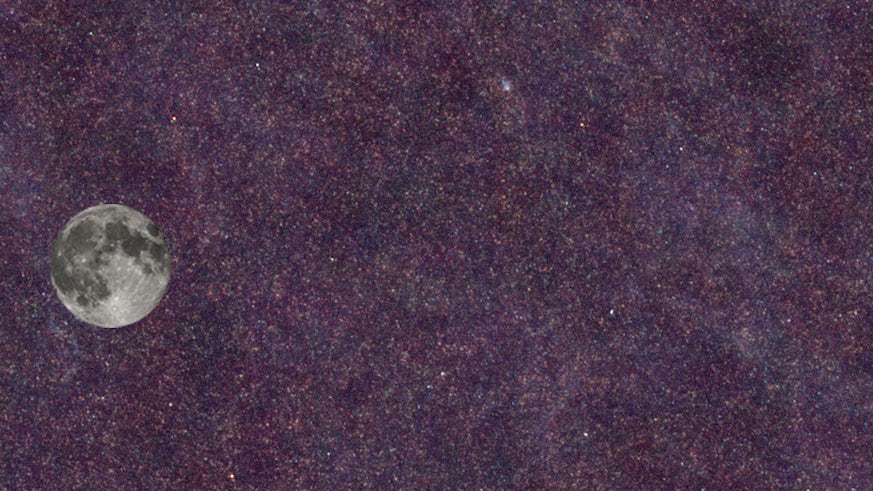A century of galaxy discrimination revealed by giant European astronomy survey
21 December 2017

A huge European astronomy survey, whose results are released today (21 December 2017), has revealed that the view of the Universe provided by traditional optical telescopes is seriously biased.
The Herschel ATLAS (H-ATLAS) was a survey carried out by an international team led by researchers at Cardiff University with European Herschel Space Observatory in the far-infrared waveband, which consists of electromagnetic waves with wavelengths 200 times greater than optical light.
Although Herschel stopped observing in 2013, the Herschel-ATLAS team has spent the last five years analysing their results, and today they released their final images and catalogues, which consist of half-a-million galaxies emitting far-infrared radiation. While the optical light from galaxies is starlight, the far-infrared radiation is from interstellar dust, tiny solid grains of material between the stars.
Deeply mysterious
Galaxies, assemblies of stars ranging from 40,000 to thousand billion stars (ours contains about one billion) are the basic building blocks of our Universe. Since they were discovered about a century ago, most of what we know about them has come from optical telescopes. However, when looked at in far-infrared light, the galaxy population looks very different.
Initially, the team used their results to measure how much dust there is in galaxies today. Cardiff University PhD student Rosie Beeston who led this work said: “Before, astronomers were trying to understand how much dust there is billions of light years away but didn’t really have a handle on how much dust resides in our own astronomical backyard because only a couple of hundred measurements existed. Now we’ve created a census of dust in over 15,000 galaxies.”
Puzzlingly, the team also found a mysterious class of galaxy with lots of gas and a bigger ratio of dust to star mass than any other type of galaxy. Dubbed BADGERS (Blue and Dusty Gas Rich Galaxies), these galaxies are deeply mysterious, since the huge amounts of dust should hide most of the optical light, and the dust is also very cold.
Dr Loretta Dunne, a research fellow at the University’s School of Physics and Astronomy, was amazed to discover these odd new galaxies: “I remember checking the optical images of our brightest 300 galaxies and being amazed that they were mostly these really messy looking blue galaxies with no obvious signs of dust. It was totally not at all what I was expecting to see, and the funny thing was I having this eureka moment in Sydney airport on my way to an H-ATLAS meeting in Cardiff.”
‘Green valley’ galaxies
Another discovery made by the team has overturned astronomers’ ideas about how galaxies evolve. All current theories of how galaxies evolve are based on the fundamental assumption that there are two classes of galaxy: galaxies in which stars are actively forming and ‘quiescent galaxies’ in which star formation has essentially stopped. This assumption is based on decades of optical surveys, which have found that most galaxies are either blue (star-forming) or red (quiescent). The existence of these two classes means that all theories need to include a catastrophic process that suddenly (in cosmic terms) converts a star-forming galaxy into a quiescent galaxy.
Most of the galaxies detected in the Herschel ATLAS, however, fall in the ‘green valley’ between the red and the blue galaxies. According to Professor Steve Eales, of the University’s School of Physics and Astronomy: “This discovery has overturned all the current theories for how galaxies evolve. Our results show that there really is only a single galaxy class...”

“There is no longer any need for a violent process that moves a galaxy rapidly from one class to the other. Herschel has shown that galaxy evolution is actually quite a gentle process.”
Cardiff Hub for Astrophysics Research and Technology (Co-Director)
The catalogues and images released by the team today will be a treasure trove for the worldwide community of astronomers. Apart from revolutionising our view of galaxies, the catalogues contain galaxies ranging from ones nearby to ones being seen only a billion years after the big bang, tens of thousands of galaxies magnified by ‘gravitational lensing’, and even tiny clouds of dust in our own galaxy. Since there is no similar mission on the drawing board for either the European Space Agency or NASA, the results from the survey will be a fundamental resource for astronomers for decades to come.

Dr Elisabetta Valiante, also of the School, who led the team that produced the galaxy catalogues: “The H-ATLAS survey is a milestone in the history of far-infrared astronomy and I expect it to be a reference for the next generation of researchers studying the formation of stars and galaxies.”
Share this story
It is a friendly, approachable School with a strong commitment to teaching excellence and world class research in physics and astronomy.







